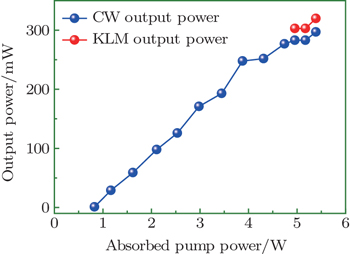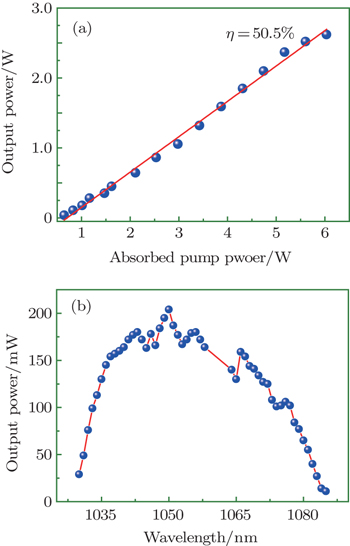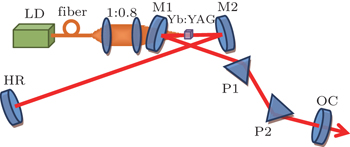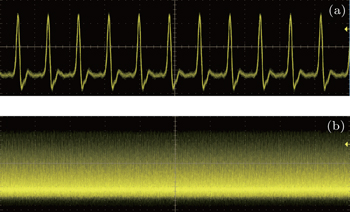† Corresponding author. E-mail:
‡ Corresponding author. E-mail:
Project supported by the National Major Scientific Instrument Development Project of China (Grant No. 2012YQ120047), the National Natural Science Foundation of China (Grant No. 61205130), and the Fundamental Research Funds for the Central Universities, China (Grant No. JB140502).
We experimentally demonstrated a diode-pumped Kerr-lens mode-locked femtosecond laser based on an Yb:YAG ceramic. Stable laser pulses with 97-fs duration, 2.8-nJ pulse energy, and 320-mW average power were obtained. The femtosecond oscillator operated at a central wavelength of 1049 nm and a repetition rate of 115 MHz. To the best of our knowledge, this is the first demonstration of a Kerr-lens mode-locked operation in a diode-pumped Yb:YAG ceramic laser with sub-100 fs pulse duration.
In recent years, there has been a growing interest in diode-pumped all-solid-state ultrafast laser with short pulse duration, high average output power, high efficiency and high reliability for many applications, including optical frequency comb, ultrafast nonlinear spectroscopy, femtosecond optical coherent tomography, and superfine material processing. Among the various Yb3+-based lasers,[1–3] Yb:YAG laser plays an important role, owing to the excellent thermal and optical properties of Yb:YAG crystal. Since the first room-temperature diode-pumped Yb:YAG laser was reported,[4] intensive continuous wave (CW) and mode-locked Yb:YAG lasers have been studied.[5–9] With the help of semiconductor saturable absorber mirrors (SESAMs),[10] femtosecond pulses with durations of 540 fs[5] and 340 fs[7] were obtained from a diode-pumped Yb:YAG laser. However, Yb:YAG crystal has a sharp and narrow emission spectrum band at a central wavelength of 1030 nm, and as a result, the pulse duration was limited to several hundreds of femtoseconds. By transferring the central wavelength from 1030 nm to 1050 nm, a broader wavelength bandwidth was expected to be excited to support the shorter pulse duration. The 136 fs[8] and 170 fs[9] pulses were generated from a passively mode-locked Yb:YAG laser in this way. By using the Kerr-lens mode-locking (KLM),[11] sub-100 fs pulses from Yb:YAG laser have been demonstrated.[12,13] Pulses as short as 35 fs with an average power of 107 mW were obtained from a diode-pumped KLM Yb:YAG laser.[13]
On the other hand, by employing the vacuum sintering technique and nanocrystalline technology,[14,15] high-quality, transparent Yb:YAG ceramics have manifested their unique advantages, such as high-doping concentration, capability of large-size fabrication, low cost, mass production, and multilayer and multifunctional components compared with the Yb:YAG crystals. It is desirable to realize high-power, high-intensity lasers based on Yb:YAG ceramics. Up to now, many experimental studies of continuous wave (CW) and mode-locked laser performances have been conducted.[15–22] The first laser action was reported in 2003, delivering a CW average output power of 345 mW with a slope efficiency of 26%.[15] Later, Yoshioka et al. successfully demonstrated the first passive mode-locking operation with an Yb:YAG ceramic, generating 233 fs pulses with an average output power of 20 mW.[20] They also reported dual-wavelength mode locking simultaneously at 1033.6 nm and 1047.6 nm based on the Yb:YAG ceramic in 2010.[21] With 3.5-W absorbed pump power, Zhou et al. realized unprecedented high-efficiency femtosecond mode-locking with the Yb:YAG ceramic, generating 1.9-W average power with 76% slope efficiency.[22] To date there has been no report on sub-100-fs laser pulse generation from an Yb:YAG ceramic by either passive mode-locking or KLM technique.
In this paper, we report on a diode-pumped Kerr-lens mode-locked Yb:YAG ceramic oscillator. Laser pulses as short as 97 fs are generated from a KLM Yb:YAG ceramic laser. The femtosecond oscillator operating at a repetition rate of 115-MHz delivers an average output power of 320 mW. The spectral bandwidth of the KLM pulses reaches 13 nm at a central wavelength of 1049 nm. This is, to the best of our knowledge, the first demonstration of a Kerr-lens mode-locked Yb:YAG ceramic laser and the shortest pulses generated from the Yb:YAG ceramic laser so far.
In a preliminary experiment, the laser performance of the Yb:YAG ceramic was investigated with a three-mirror folded cavity. Figure
In the experiment of KLM operation, a standard X-folded linear cavity was employed. Figure
At first, we adjusted the cavity in order to generate the highest CW output power. Under an absorbed pump power of 5.4 W, the maximum average output power was 370 mW. Subsequently, we finely adjusted the position of mirror M2 to the stability edge of the cavity. When the absorbed pump power exceeded 4.9 W, a stable Kerr-lens mode-locking operation was obtained by slightly translating the end mirror. Once mode-locked, the average output power increased from 283 mW to 303 mW. The Kerr-lens mode-locked pulse train was detected by a fast photodiode and recorded with a digital storage oscilloscope. Figure
 | Fig. 5. Average output powers of the Yb:YAG ceramic laser each as a function of absorbed pump power for both CW operation and KLM operation, respectively. |
In this paper, we demonstrate the first sub-100-fs pulse generation from a diode-pumped Kerr-lens mode-locked Yb:YAG ceramic laser. The laser pulse duration is as short as 97 fs at a central wavelength of 1049 nm. The average output power is 320 mW under an absorbed pump power of 5.4 W. To the best of our knowledge, this is the first time Kerr-lens mode-locking operation has been realized in an Yb:YAG ceramic. In terms of their advantages, Yb:YAG ceramic is a promising candidate for constructing the high-power femtosecond laser amplifiers with sub-100 fs pulse duration.
| 1 | |
| 2 | |
| 3 | |
| 4 | |
| 5 | |
| 6 | |
| 7 | |
| 8 | |
| 9 | |
| 10 | |
| 11 | |
| 12 | |
| 13 | |
| 14 | |
| 15 | |
| 16 | |
| 17 | |
| 18 | |
| 19 | |
| 20 | |
| 21 | |
| 22 |







